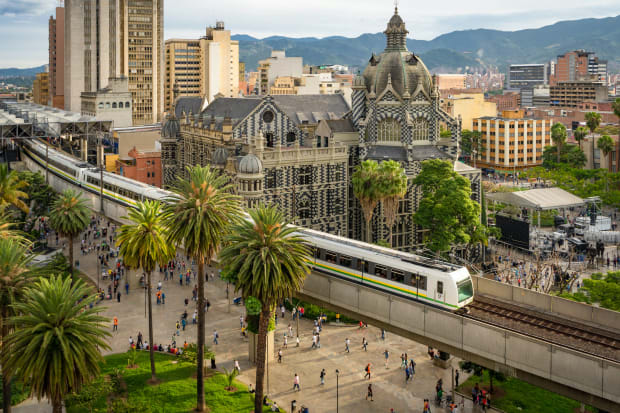
Many companies may be tightening their work-from-home policies, but the flocks of digital nomads--people who consistently combine travel with remote work--aren’t disappearing.
One study says that 16.9 million American workers currently describe themselves as digital nomads--131% more than in 2019, and Forbes says that some estimate there are 35 million digital nomads worldwide. Data gathered by Nomad List, a crowd-sourced tool for digital nomads, finds that 23 million Americans are traveling digital workers.
A wave of remote workers from around the world have descended on Mexico City, especially since 2019, the New York Times reports, and the flow of foreigners has yet to slow down.
Spain is now launching a digital nomad visa, allowing remote workers who earn at least 2,000 euros a month to stay in the country up to a year. Since 2020, at least 30 countries, including the Bahamas, Portugal, Croatia, Mexico, and Costa Rica have launched some kind of visa to attract remote workers, according to Apartment Therapy.
Who are these workers? They identify as males and females, mostly ages 28-39, and have a higher education, according to data gathered by Nomad List. Some 65% are single, with a median income of $85,000 a year, half are homeowners, and the majority work in software or web development, marketing or creative industries or have founded a startup. They really like coffee.
Generally, according to the Nomad List data, 59% will stay in one country for 7-30 days and 28% stay for 30-90 days.
Where do they go? Some of the most popular places on Nomad List include large cities like Lisbon, London, Bangkok, Barcelona, Paris and Mexico City. But other places seem to be trending.
The destinations on this list are ranked by growth rates of check-ins made to places by tens of thousands of Nomad List members using data analyzing 238,496 check-ins. The primary rank is the most recent growth in check-ins. This list uses the data from early January.
Here are the fastest growing remote work hubs in the last five years (excluding 2020, due to covid), from 2018 to 2022.
The list also includes fast-growing, already-established remote work hubs, plus 10 places that have consistently grown and have low-priced real estate (a median 1-bedroom house under $350,000) in countries that let foreigners legally own real estate.
Fastest-Growing Remote Work Hubs of the Past 5 Years
These remote work hubs have consistently grown in check-ins in the last 5 years (except 2020, due to COVID), from 2018 to 2022:

1. Palermo, Italy
- 5-year growth: +500%
- 2022 growth: +214%
- 2021 growth: +110%

2. Skopje, North Macedonia
- 5-year growth: +417%
- 2022 growth: +160%
- 2021 growth: +114%

3. Azores, Portugal
- 5-year growth: +361%
- 2022 growth: +44%
- 2021 growth: +125%

4. Yerevan, Armenia
- 5-year growth: +308%
- 2022 growth: +157%
- 2021 growth: +900%

5. Mallorca, Spain
- 5-year growth: +293%
- 2022 growth: +83%
- 2021 growth: +108%

6. Lima, Peru
- 5-year growth: +258%
- 2022 growth: +213%
- 2021 growth: +60%
Simon Mayer / Shutterstock

7. Sofia, Bulgaria
- 5-year growth: +237%
- 2022 growth: +78%
- 2021 growth: +359%
Shutterstock

8. Antalya, Turkey
- 5-year growth: +225%
- 2022 growth: +59%
- 2021 growth: +228%
Shutterstock

9. Naples, Italy
- 5-year growth: +219%
- 2022 growth: +83%
- 2021 growth: +59%

10. Medellín, Colombia
- 5-year growth: +215%
- 2022 growth: +137%
- 2021 growth: +130%
Fastest Growing Already-Established Remote Work Hubs in the Past 5 Years
Here are the destinations that are growing fast in the last 5 years (except 2020, due to COVID) and already have a high amounts of remote workers there now.

1. Lima, Peru
- 5-year growth: +258%
- 2022 growth: +213%
- 2021 growth: +60%
Dan Breckwoldt / Shutterstock

2. Sofia, Bulgaria
- 5-year growth: +237%
- 2022 growth: +78%
- 2021 growth: +359%

3. Gran Canaria, Canary Islands, Spain
- 5-year growth: +221%
- 2022 growth: +110%
- 2021 growth: +105%

4. Medellin, Colombia
- 5-year growth: +215%
- 2022 growth: +137%
- 2021 growth: +130%

5. Playa del Carmen, Mexico
- 5-year growth: +213%
- 2022 growth: +0%
- 2021 growth: +107%

6. Lisbon, Portugal
- 5-year growth: +202%
- 2022 growth: +96%
- 2021 growth: +124%

7. Tbilisi, Georgia
- 5-year growth: +197%
- 2022 growth: +39%
- 2021 growth: +685%

8. Belgrade, Serbia
- 5-year growth: +181%
- 2022 growth: +36%
- 2021 growth: +104%
Shutterstock

9. Toronto, Canada
- 5-year growth: +175%
- 2022 growth: +131%
- 2021 growth: +30%
Bob Noah / Shutterstock

10. Porto, Portugal
- 5-year growth: +172%
- 2022 growth: +124%
- 2021 growth: +220%
Consistently-Growing Remote Work Hubs With Affordable Real Estate
Here are the places with low-priced real estate (a median 1-bedroom house under $350,000) in countries that let foreigners legally own real estate.
Shutterstock

1. Banja Luka, Bosnia
- 5-year growth: +500%
- 2022 growth: +200%
- 2021 growth: +100%

2. Palermo, Italy
- 5-year growth: +500%
- 2022 growth: +214%
- 2021 growth: +110%

3. Skopje, North Macedonia
- 5-year growth: +417%
- 2022 growth: +160%
- 2021 growth: +114%

4. Azores, Portugal
- 5-year growth: +361%
- 2022 growth: +44%
- 2021 growth: +125%

5. Mallorca, Spain
- 5-year growth: +293%
- 2022 growth: +83%
- 2021 growth: +108%

6. Milwaukee, Wis., U.S.
- 5-year growth: +286%
- 2022 growth: +57%
- 2021 growth: +17%

7. Lima, Peru
- 5-year growth: +258%
- 2022 growth: +213%
- 2021 growth: +60%

8. Puebla, Mexico
- 5-year growth: +250%
- 2022 growth: +118%
- 2021 growth: +175%

9. Odessa, Ukraine
- 5-year growth: +250%
- 2022 growth: -87%
- 2021 growth: +77%

10. Dakar, Senegal
- 5-year growth: +250%
- 2022 growth: +200%
- 2021 growth: +50%
You can see the live data on the fastest-growing work hubs at NomadList.com.






